In this edition of our Top MBA Program Career Placement Outcomes series, we review the data to see to what extent Class of 2021 graduates from leading full-time U.S. MBA programs accepted jobs in their school’s same region.
For this analysis, we reviewed the employment reports from 27 full-time MBA programs* based in the U.S. This analysis is focused on graduates of full-time U.S.-based MBA programs who were seeking employment, received an offer, and accepted an offer within three months of graduation. Next, we looked at what region these MBA graduates went to school in and compared it to what region they reported to work in post-MBA.
Here is a visual map of the US regions:
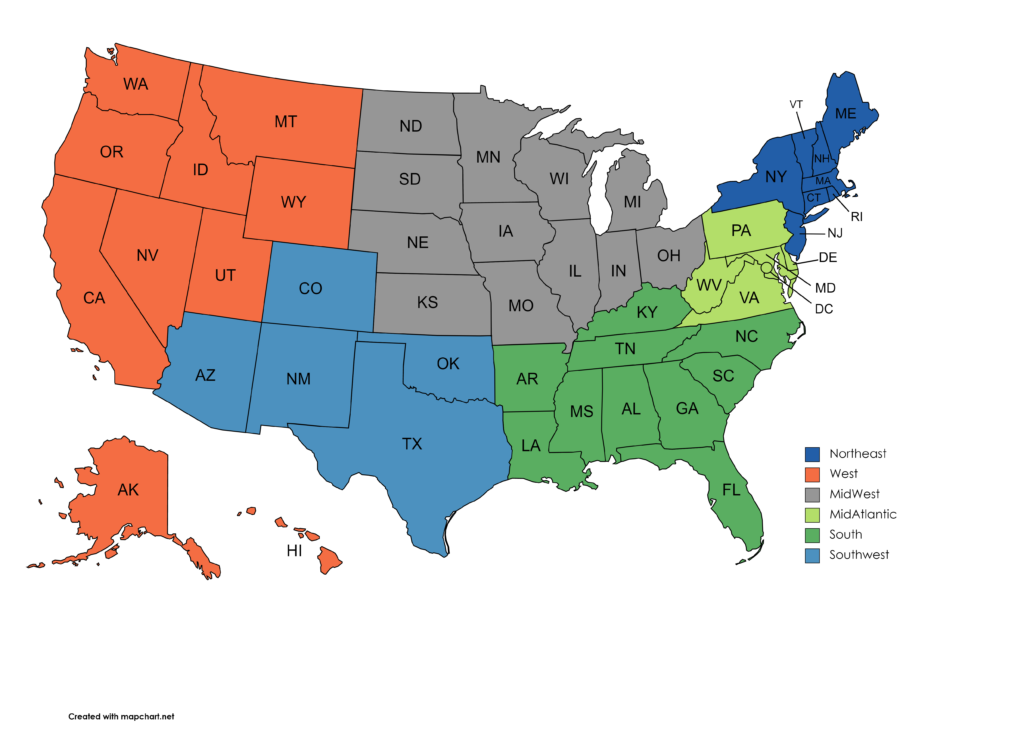
Now we will review the data by region.
U.S. Northeast Full-time MBA Programs
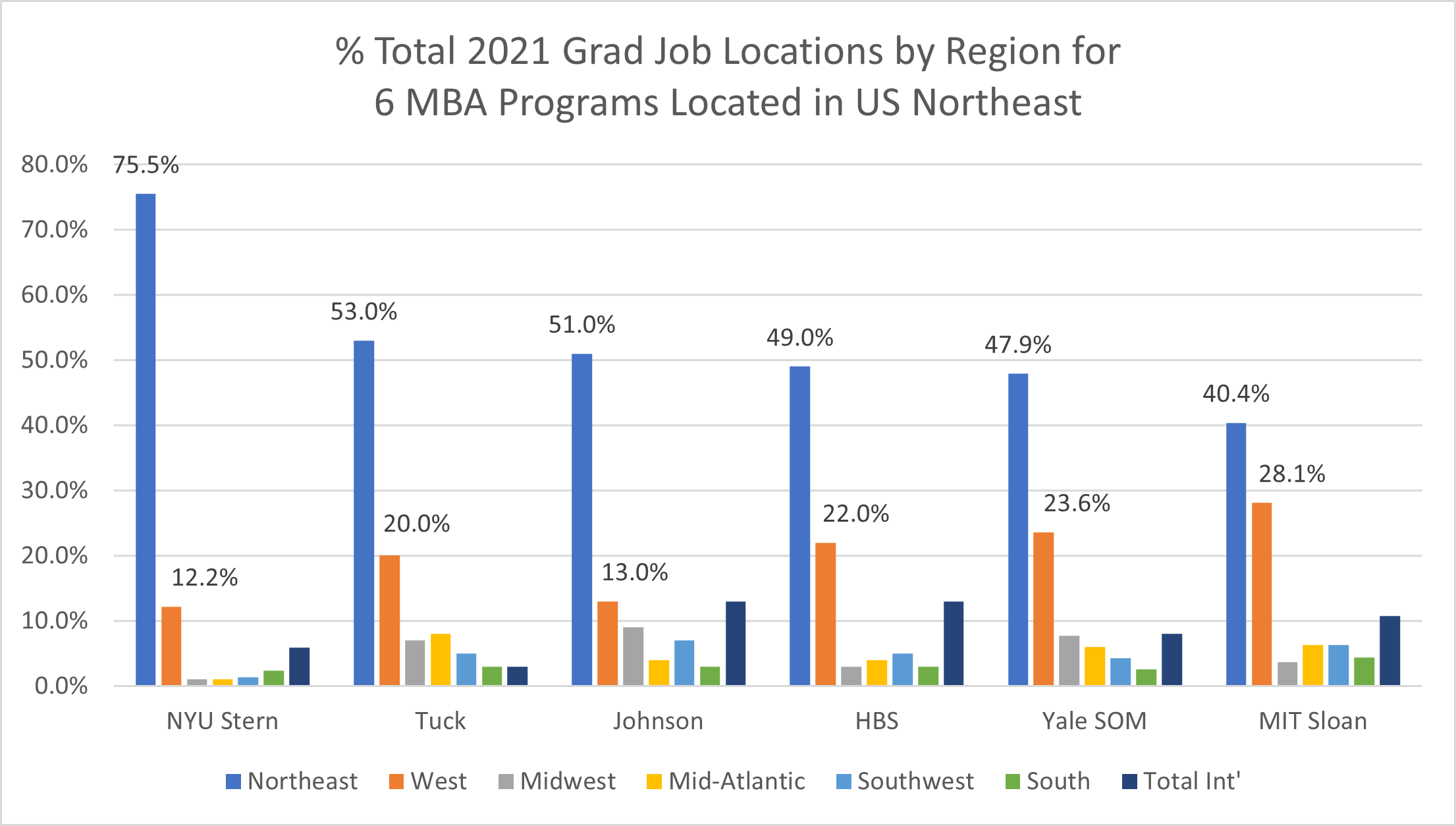
About half of the Class of 2021 graduates of these leading Northeast MBA programs accepted jobs in the Northeast U.S. The Northeast does include the finance and tech hubs in both New York City and Boston, so it is understandable that Northeast based MBA programs would help graduates land jobs in both cities. MIT Sloan job placement by region is a bit more diversified – sending only 40% to the Northeast, 28% to the West and 11% international. Boston and NYC are both finance and tech hubs, while Boston has a number of buy-side firms.
Note on CBS. Of the MBA programs reviewed in this analysis, CBS is the only school to not publish information about the job location by region for the Class of 2021. Thus, we did not include CBS in the table above.
Note on Wharton: Wharton is located in Philadelphia, PA, which is defined in the employment reports as part of the U.S. Mid-Atlantic region. Having said this, Wharton’s job placement by region is more similar to the job placement by region for leading MBA programs located in the Northeast. Given this, for comparison purposes we have created an alternate Northeast chart that includes Wharton in the Northeast region:
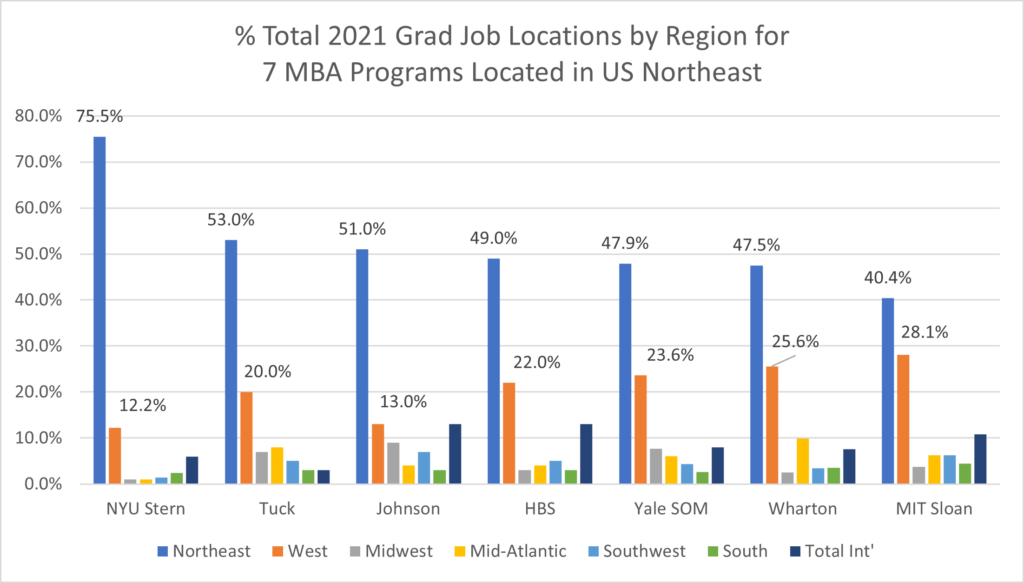
Wharton’s job placement by region is similar to HBS and Yale’s job placement by region. The exception is that Wharton has a higher percentage of job placement in the U.S. Mid-Atlantic region.
U.S. West Full-time MBA Programs
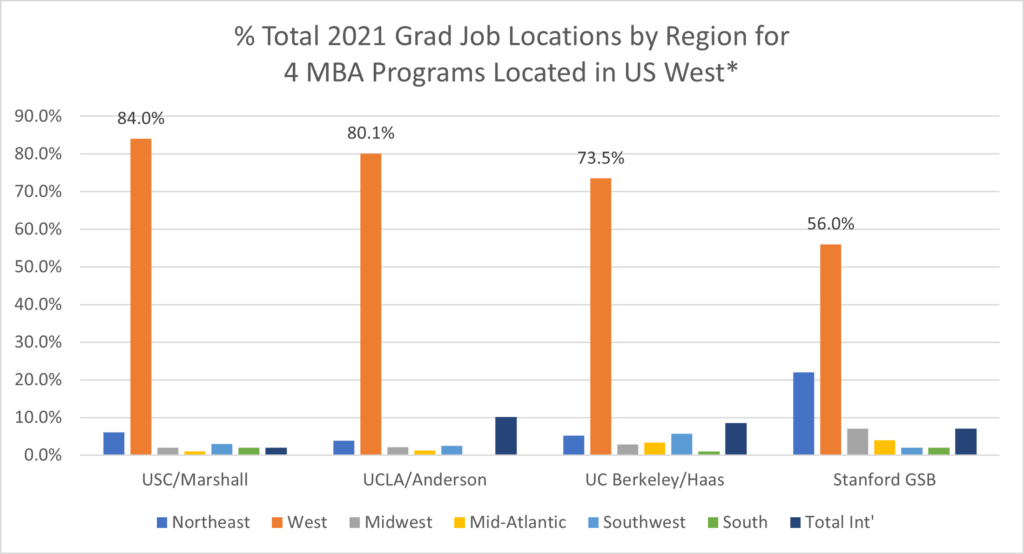
The West Coast full-time MBA programs overwhelmingly send graduates to work in the U.S. West.
Stanford GSB is the only business school that sends a sizeable number (20%) of graduates accepting jobs to the Northeast, but 56% still work on the West Coast. This makes sense given the popularity of MBAs seeking jobs in the tech industry and the concentration of tech firms and venture capital firms there.
Note on U. Washington/Foster: In Foster’s Class of 2021 employment report, it states that 64% of the Foster Class of 2021 graduates accepting jobs chose jobs located in Washington State, 35% chose jobs in the rest of the U.S. and 1% chose jobs outside the U.S. Because Foster didn’t break down the accepted jobs by U.S. region, we couldn’t include it in the table above.
U.S. Midwest Full-time MBA Programs
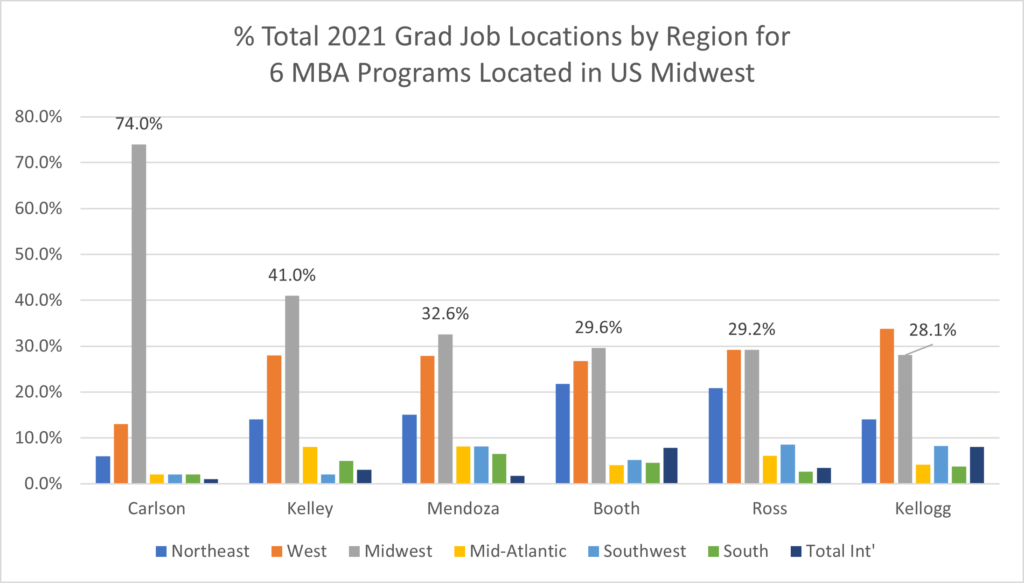
In contrast to the U.S. full-time MBA programs located in the Northeast and West, 2021 Graduates of Midwest MBA programs are well represented in multiple regions: the Northeast, Midwest and West. In fact, Kellogg actually sent more graduates to jobs in the West (33.8%) than to jobs in the Midwest (28.1%). Ross is evenly split between West (29.2%) and Midwest (29.2%) job placements while Booth sent 21.8% to the Northeast, 26.8% to the West and 29.6% to the Midwest. Mendoza and Kelley Class of 2021 graduates accepted more Midwest job placements, but a sizable number still landed in the West and the Northeast. Carlson places predominantly in the Midwest.
U.S. Mid-Atlantic Full-time MBA Programs
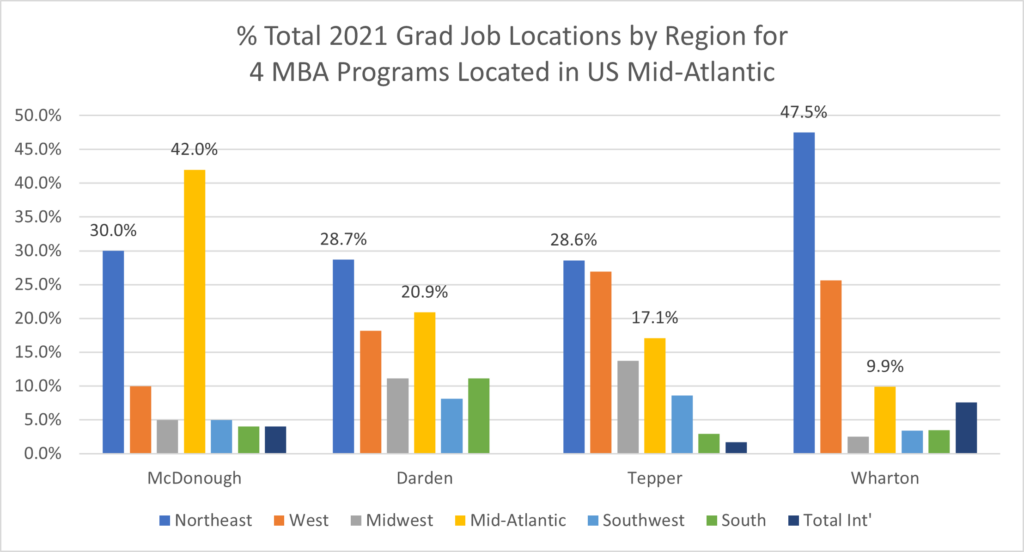
While Wharton is located in the Mid-Atlantic, its job placement location profile is more like a Northeast program. Of the Wharton Class of 2021 graduates accepting jobs, 47.5% went to the Northeast and 25.6% to the West. Only 9.9% of the Wharton class took jobs in the Mid-Atlantic. Meanwhile, McDonough graduates accepted jobs more in the Mid-Atlantic (42%) than in the Northeast (30%).
Both Tepper and Darden graduate job placement numbers are more evenly distributed across the U.S. Tepper sends 28.6% to the Northeast, 26.9% to the West, 17.1% to the Mid-Atlantic, 13.7% to the Midwest, and 8.6% to the Southwest. Similarly, Darden sends 28.7% to the Northeast, 18.2% to the West, 20.9% to the Mid-Atlantic, 11% to the Midwest, 8% to the Southwest and 11% to the South. In fact, one could argue that Tepper and Darden are some of the most nationally diverse MBA programs given the geographic distribution of job placement.
U.S. Southwest Full-time MBA Programs
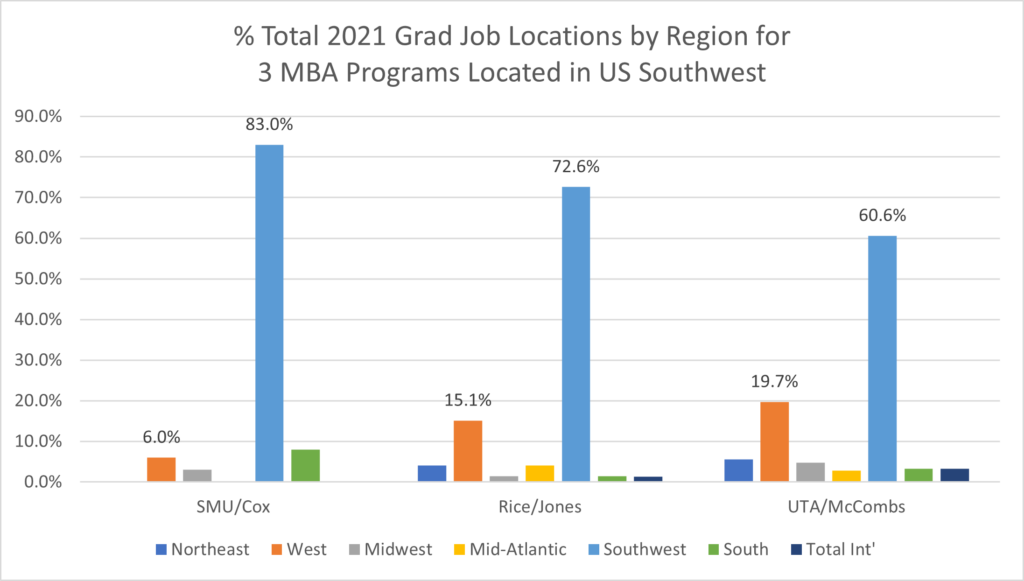
All three programs overwhelmingly send their graduates to jobs in the Southwest, particularly for tech and energy jobs in Texas. Of the Class of 2021 graduates accepting jobs, McCombs does send 19.7% to the West and Rice sends 15% to the West.
U.S. South Full-time MBA Programs
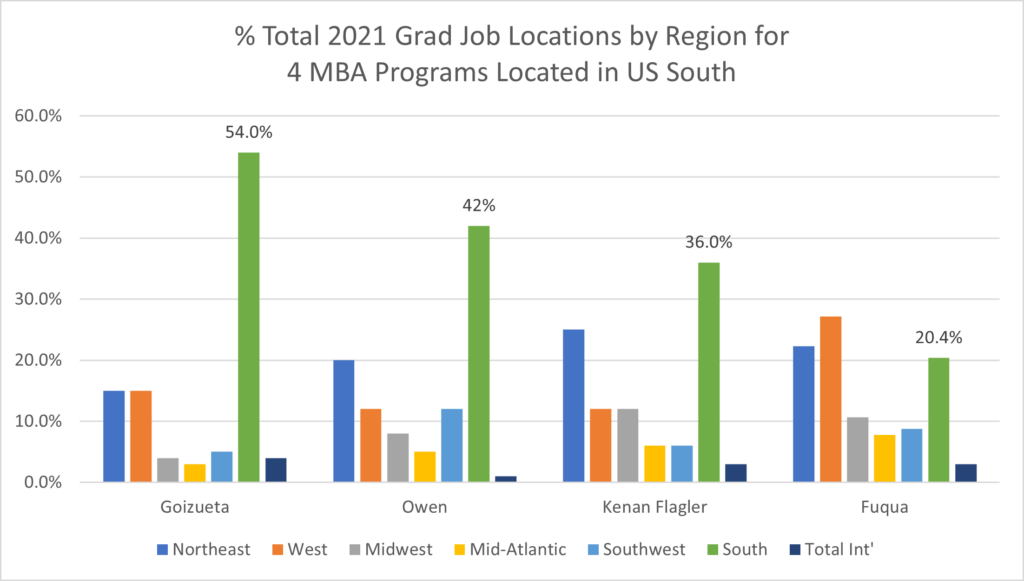
Of the Class of 2021 graduates seeking jobs, Fuqua’s job placement location data is pretty balanced by region, sending 27% to the West, 22% to the Northeast and 20% to the South. While UNC does send 36% to the South, it also sends 25% to the Northeast and 12% each to the West and Midwest. Emory (54%) and Owen (42%) are more concentrated in the South.
Conclusion
In summary, it is interesting to see how many top-ranked MBA programs with global brands such as Stanford and HBS send many graduates to jobs in their own region. “One reason is because there are a lot of global firms located in their regions,” says Graham Richmond, Co-Founder of Clear Admit. “For example, Stanford GSB graduates have easy access to big tech firms and venture capital firms located on the West Coast and HBS graduates have easy access to top finance, tech and consulting jobs in Boston and New York City. In fact, these MBA programs’ proximity to global cities with leading global firms is a key advantage.”
In contrast, MBA graduates from top MBA programs located farther away from the headquarters of global firms are more likely to leave the region of their MBA program to land a position. “You could argue that business schools like Darden, Fuqua and Tepper have better national reach in the U.S. because they send a significant percentage of graduates to other parts of the country,” Richmond noted.
*27 U.S.-based MBA Programs by region: Northeast – Cornell Johnson, Dartmouth Tuck, HBS, MIT Sloan, NYU Stern and Yale SOM; West – Berkeley Haas, Stanford GSB, UCLA Anderson and USC Marshall; Midwest – Chicago Booth, Indiana Kelley, Michigan Ross, Minnesota Carlson, Northwestern Kellogg, and Notre Dame Mendoza; South – Duke Fuqua, Emory Goizueta, UNC Kenan-Flagler and Vanderbilt Owen; Mid-Atlantic – CMU Tepper, Georgetown McDonough, UPenn Wharton, UVA Darden; Southwest – Rice Jones, SMU Cox and UT Austin McCombs.





